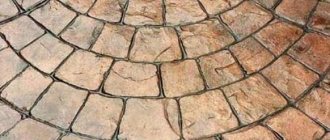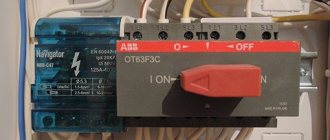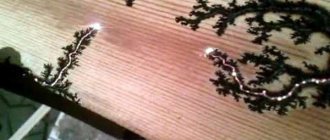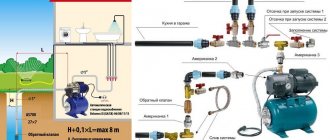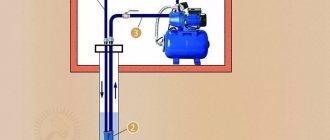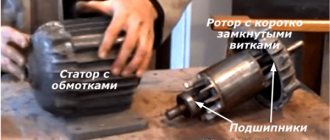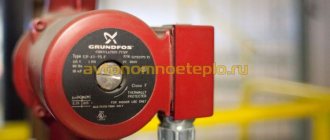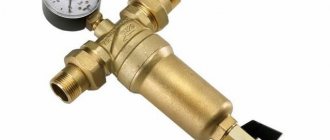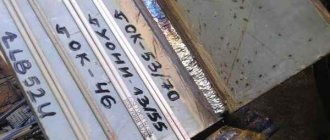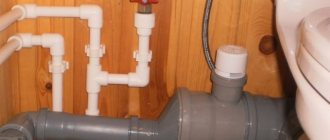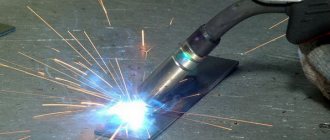Change in resistivity during electrical heating of various grades of concrete
| Cement manufacturing plant | Initial electrical resistivity, Ohm | Minimum electrical resistivity, Ohm |
| Belgorodsky | 18,8 | 12,2 |
| Zhigulevsky | 9,6 | 7,4 |
| Podolsky | 11,5 | 9,7 |
| Rostovsky | 8,5 | 7,2 |
| Spassky | 8,0 | 4,9 |
| Teploozersky | 9,2 | 6,8 |
Upon completion of concreting and installation of electrodes, the surface of the solution is covered with insulating materials. Heating concrete with uncovered surfaces is not allowed.
Electrode heating is well combined with concrete curing using the thermos method. Only the outer layers are heated with electrodes to avoid loss of heat received by the solution before pouring.
Types of electrodes
There are several types of electrodes used to heat concrete mortar. The most used of them:
Plate electrodes
Plastic electrodes are metal plates that are placed between the formwork and concrete on different sides of the structure. After connecting an electric potential to them, a field is formed that heats the solution.
Strip electrodes
This type of electrodes consists of metal strips ranging from 20 to 50 mm wide. They are also located on the top layer of the solution. Their distinctive ability is the possibility of their location on only one side of the structure. In this case, the electrodes are connected alternately to different phases.
Strip electrodes are used when heating floor slabs and other horizontal elements, as well as concrete in contact with frozen soil.
Rod electrodes
Rod electrodes are essentially reinforcement rods up to 15 mm in diameter, which are located directly in the concrete body.
They can warm up the concrete of structures of complex shape: beams, columns, massive slabs, foundation shoes, side surfaces of massive structures.
String electrodes
String electrodes are used mainly for heating columns. They are 2-3 meters long and about 15 mm thick. A string electrode is installed in the center of the structure. An electric field arises between the string and the formwork, covered with a conductive sheet and connected to another phase of the electrical network.
In some cases, reinforcing elements of the structure itself can be used as electrodes. At the same time, energy costs increase significantly.
Conditions for pouring concrete in winter
- The transport in which the solution is transported must be insulated to prevent heat loss. That is, it must be closed.
- The concrete and formwork to be laid must be heated, the solution is laid and compacted immediately.
- Snow should not fall on the installed reinforcement and formwork. In order to warm up the formwork and mortar, do not use hot water.
- Do not pour onto frozen soil or structure.
- The first days, the temperature of the solution should be at least +10 degrees, all rooms adjacent to the building should be heated.
At low temperatures, the hardening of the solution stops, as a result, the basic structure of the structure is damaged, which subsequently cannot be restored. After concreting is completed, the structure is covered with insulation, otherwise there is no point in heating the solution. Typically, electrodes are used to heat the exterior layers to prevent heat loss. Before you begin the main work, you need to make accurate calculations and purchase the necessary materials. Thanks to this method, it is possible to heat structures of various thicknesses and configurations, but this method is not effective for constructing slabs. The type of electrodes is chosen depending on weather conditions and the quality of the material used. Strip electrodes can be used to heat floor slabs and other elements located horizontally, as well as concrete that touches frozen ground. Rod electrodes are used for heating columns, beams and other complex structures. String electrodes are used to heat columns; if the structure contains metal components, then the electrical energy consumption will be higher. When heating concrete using the electrode method, the structure must be covered, otherwise significant heat loss will occur and a large consumption of electrical energy will occur; the desired result cannot be achieved. Correct connection and voltage supply also depend on the type of electrodes used. If the work is done correctly, the solution quickly hardens, gives minimal shrinkage, and does not collapse due to frozen water, which is part of the mixture. If it is difficult to do the work yourself, then you need to seek the help of specialists.
Electrode installation diagrams
| Electrode type | Installation and connection diagram |
| Lamellar | |
| Strip | |
| Rod | |
| Strings |
In the table, the phases are indicated by the numbers f1, f2, f3.
Advantages of heating with electrodes
- fairly high efficiency;
- heating of structures of any thickness, regardless of shape.
Disadvantages of heating with electrodes
- significant time for preparation;
- carrying out preliminary calculations;
- additional equipment (transformers);
- high energy consumption from 1000 kW for 3-5 cubic meters of concrete mixture;
- poor applicability when pouring slabs.
With the surface arrangement of the electrodes, only structures of small thickness can be fully heated. Otherwise, only peripheral heating will occur.
Just ten years ago, during the winter period, almost all construction work lost its intensity. This was primarily due to sub-zero temperatures. But even if the workers could dress warmly, it was extremely problematic to carry out concreting in such conditions. However, after some time, a very effective method appeared - heating the concrete with electrodes and using an electric cable. Let's take a closer look at the features of this method and talk about its feasibility.
What is it for?
Before delving into this topic, it is necessary to talk about what it is actually used for. The fact is that any concrete contains a certain amount of water. It is quite natural that at sub-zero temperatures it forms ice crystals. The latter lead to the fact that a lot of pressure is exerted on the pores of the concrete, which ultimately leads to partial or complete destruction of the structure. In this case, the final strength is significantly reduced, and performance characteristics deteriorate.
Another dangerous factor is freezing of water during the setting (hardening) period. The fact is that at low temperatures the interaction between the concrete mixture and water slows down. This stops the hardening process, making it uneven. That is, there is no need to talk about any declared strength. Nevertheless, today there is more than one scheme for heating concrete with electrodes, which allows you to keep the humidity and temperature characteristics within an acceptable range.
Read also: Wood cutting disc for angle grinders
About winter concreting methods
It is worth drawing your attention to the fact that today not only the electrode is used. This is due to the fact that sometimes this method is not suitable or its use is too expensive for developers. In addition, much depends on the conditions (temperature, humidity, purpose of the future structure). For this simple reason, there are a number of other methods for concreting in winter. For example, heating in a heating formwork. This method is very effective and good, but it is only advisable for small thicknesses. By the middle, the concrete will still freeze a little and the thicker it is, the more harmful the effect of sub-zero temperatures will be. There are also antifreeze additives that make the mixture more resistant to frost. There is induction heating using special wires. But the most popular method is to use electrodes.
Optimal cable characteristics
- Specific resistance - 0.15 Ohm/m.
- Operating temperature ranges from -60°C to 50°C.
- Consumption - no more than 60 m of cable per cubic meter of solution.
- Safe installation at -15°C.
Installation features
The PNSV cable is laid in a “snake” pattern (the pattern is similar to “warm floor” systems) after the installation of formwork and reinforcement. The interval depends on weather conditions and can be 8-20 cm. No tension is allowed in the wire; the product is attached to the fittings using clamps
It is important that the current-carrying conductors do not touch, and the bending radius is not less than 25 cm. This approach will ensure high-quality heating of the concrete with heating wires. The scheme allows you to use cable sparingly
The scheme allows you to use cable sparingly.
Counting wire length
When calculating the heating of concrete by PNSV wire, it is important to take into account humidity, air temperature, shape of the future structure, its volume, and thermal insulation. The amount of heat required for the correct hardening of concrete depends on these nuances. The distance between the cores during installation, and therefore the length of the required cable, changes based on the temperature conditions
The step is 20 cm if it is -5°C outside. A further decrease in temperature by 5 degrees leads to a decrease in pitch by 4 cm
The distance between the cores during installation, and therefore the length of the required cable, changes based on the temperature conditions. The step is 20 cm if it is -5°C outside. A further decrease in temperature by 5 degrees leads to a decrease in pitch by 4 cm.
Power consumption is also important in calculations. The product of resistivity and current squared will allow you to find out this indicator for 1 meter of cable. The current in the system should not exceed 16 A, and the resistivity for a 1.2 mm PNSV wire is 0.15 Ohm/m.
Alternative systems
VET and KDBS cables also allow you to achieve good results. Their advantage is a simple connection to a 220 V network through a socket or panel. Overloads are excluded, because the wires are divided into sections. But the price of the products is higher, and financial losses on the construction of large facilities will be significant.
At the same time, thermal insulation is used, which will speed up the process of heating the solution and make the temperature decrease uniform.
When are electrodes used?
Each of the above methods is used in one situation or another. As for the electrodes, this is not a universal solution. For example, when pouring a concrete slab, it is completely ineffective. In this case, it is better to use a heating wire. But if we are talking about any vertical structure, then electrode heating will be an excellent solution.
By the way, sometimes natural insulation is used, which is often not enough. In this case, an electrode is suitable as additional heating. But you need to understand that the wider the design, the lower the efficiency and the higher the cost, but we will return to this issue later. Fortunately, today the technology of heating concrete in this way has been mastered and is widely used by builders from all over the world. Nevertheless, in the Russian Federation, most buildings use wire heating.
It should be noted that the technology of heating concrete with electrodes requires only 3 workers. This is a significant advantage, since many people are not needed. In addition, it is worth mentioning the effectiveness of the method. This solution ensures not only uniform setting of the mixture, but also does not violate the integrity of the structure. This is a rather important point, since this factor directly affects the strength and durability of the product. Another important factor is the simplicity and high speed of installation. This is especially true during severe frost. In addition, it cannot be said that for a column it is often sufficient to use only one electrode.
We have looked at the strengths, but now it makes sense to talk about the disadvantages that are also present here.
How to heat concrete with a wire
Wire laying
Necessary conditions for work
Wire laying is carried out at air temperatures from -25 to +50 degrees.
You need to calculate in advance how much wire you will need. Presumably, there are approximately 55 m of wire per 1 m3.
Warming up concrete with PNSV wire in winter is completely safe, because such wire is made with a good insulating sheath.
Due to the strength of the core, there is almost no possibility of creasing.
In no case should you connect the wire to the network until you immerse it in the concrete mixture, because this risks burning out due to the increased current.
Heating concrete with PNSV wire is used not only for domestic purposes, but also for industrial ones.
Calculation of wire for heating concrete
For one cubic meter of concrete we need approximately 55 m of wire. To find out what length of wire will be needed, you need to find out how much concrete will be poured. Thus, for 20 m3 we need 1100 m.
Cable installation and grouting
There is some difficult work to be done to install the cable.
- First, you need to clean the surface of all kinds of debris and various foreign objects, this will protect the wire from damage.
- Then you need to make sure that the wire does not bend. To do this, the wire is laid in a semicircle, but so that there are no empty zones.
The most common pattern for laying cables is a snake.
Electrical connection
After all the manipulations described above, fill and connect.
To connect the cable, you need to connect it to a power source, and when connecting, it is recommended to use a transformer.
After you have connected the cable, you must follow the safety precautions:
- there should be no voltage drops,
- To avoid changes, use a stabilizer.
According to the recommendations of experts, it is necessary to use stations for warming up the following brands: “SPB-40 and SPB80”.
The wire is connected according to two schemes: “Star” and “Triangle”.
In the “Triangle” scheme, the wire strands are divided into three equal parts and the wires of each part are mated in parallel.
The resulting sets must be connected into three nodes and connected to three station clamps.
Warming up
Before you start heating the concrete, you need to find out the heating time.
Initially, the solution will heat up, but the temperature cannot be increased by more than ten degrees.
The second stage will be an increase in temperature by no more than eighty degrees.
The final stage will be the cooling of the concrete, but you should not lower the temperature by more than five degrees within an hour.
Work after warming up
Builders often ask: “Can concrete be drilled immediately after it has hardened?”
This question can be answered positively, but several nuances must be taken into account.
You can cut concrete, but you don't need to perform impact loads.
When cutting, it is better to use a diamond tool.
If you use such a tool, when drilling, the hole in the concrete will have smooth edges.
Also, if you cut a hole in concrete with a diamond crown, then at the moment when the crown reaches the reinforcement, you will not have to change it.
Disadvantages of heating with electrodes
In our case, we need to talk about using wire rod reinforcement as electrodes. Usually it is selected with a diameter of 8-10 millimeters, which is quite enough for effective work. It would seem that there could be some shortcomings here, but they exist.
Firstly, it requires quite a lot of energy. Each electrode will consume about 50 A. In this case, it is necessary to use step-down transformers. For example, an 80 kW model will not handle much. Therefore, in addition to electrodes, you need to buy additional equipment, which is quite expensive.
Another significant drawback due to which many developers bypass this method is the high cost. The fact is that wire rod electrodes are disposable. After their installation, they remain forever in the body of the structure, and it is not possible to remove them. But those who nevertheless decided to use this method remain satisfied. The strength of the structure is maintained for a long time, and the performance characteristics are at a high level.
Heating concrete with electrodes: technology
Now let's briefly look at the essence of this method. As noted above, it is not suitable for pouring a concrete slab, only for columns, walls, and diaphragms. After the pouring work is completed, metal rods are inserted into the walls. They are supplied with voltage through a step-down transformer. Typically, an interval between two adjacent electrodes is chosen from 60 to 100 centimeters, which depends on both the weather and the configuration of the object.
Three phases are supplied from the step-down transformer to the fittings, as a result of which the space between the electrodes is heated and freezing is prevented. It is worth drawing your attention to the fact that heating concrete in winter is based on the passage of electric current through the water contained in the solution. As a result, we have uniform heating. You need to understand that if there is a reinforcement frame, then the voltage should not be more than 127 V, and if there is none, then 220 and 380 V can be supplied, but no more.
Read also: Reducer BKO 50 4 oxygen
TMO for heating concrete purpose, characteristics,
TMO concrete heating is a development that allows for the casting and laying of ready-mixed concrete in a monolithic building at subzero temperatures without disrupting the technological process that provides the material with hardening and normal maturation conditions. We would like to tell you about the characteristics and purpose of equipment for transformer heating of concrete.
Methods
There are different methods for heating concrete for casting and winter placement.
The following technologies are used with varying frequency:
- Construction of shelters, heated houses, other structures and superstructures that prevent direct contact of the working area with cold air. Quite often used in conjunction with heaters powered by electric, solid fuel, diesel or gas. Refers to expensive and ineffective methods that are unsuitable for large-scale objects;
- Application of heated formwork. It assumes the presence of special equipment for the construction of formwork with heating elements, and a set of connecting and supply wires, transformers and system protection and control automation. Suitable for small structures, walls and other standard elements;
- Electrode heating of concrete. It is based on the thermal effect characteristic of the passage of electric current through a conductor with resistance, the only conductor here being the solution itself. It is characterized by low efficiency and enormous energy consumption, suitable for pouring vertical walls, columns and diaphragms;
- Warming up the concrete using the PNSV wire (1, 2). A special wire is placed in the formwork, which heats up when an electric current passes through it. Heating of concrete with TMO and wires is characterized by high efficiency and low energy costs, is suitable for various, as well as massive and non-standard structures, and is characterized by complex preparation;
- Infrared heating. Here the solution is heated with special radiating mats, but there is the problem of water evaporation. The method is suitable for slabs and small horizontal and thin-walled structures;
- Induction heating. Based on the phenomenon of electromagnetic induction: a coil with a conductor forms an alternating electromagnetic field, which induces a current in the reinforcement frame of the structure, as a result of which it heats up. It is distinguished by complex calculations and expensive equipment for the thermal effect and the number of turns.
Note! Analysis of all methods of increasing the temperature of the solution allows us to single out heating through wires as the most universal and effective, relevant for structures of different shapes and sizes and suitable for working with huge volumes of concrete. Then we will look at the main power source for electric concrete heating systems - stations and transformers that supply the conversion of mains voltage to acceptable values, and the regulation and supply of operating current at the site
Then we will look at the main power source for electric concrete heating systems - stations and transformers that supply the conversion of mains voltage to acceptable values, and the regulation and supply of operating current at the site.
Types of electrodes used
Currently, three types of electrodes are used. Each of them is suitable for certain situations. For example, rod electrodes, which are among the most popular, are made from reinforcement with a diameter of 8-12 mm. They are installed in the concrete body with a calculated step, which is determined in advance. The outermost row is mounted no further than 3 centimeters from the formwork, which guarantees complete heating of the edges of the wall or column. It is noteworthy that these electrodes are suitable for structures of the most complex shapes.
But plate electrodes work somewhat differently. They are hung on different sides of the formwork. As a result, an electric field is created that heats the concrete to the desired temperature within a certain time. In principle, heating concrete in winter using this method is very effective. String electrodes are best suited for structures such as columns.
Use of welding machines
Heating concrete with a welding transformer is a widely used method that provides good heating performance of the structure with the additional use of heating elements of various types.
The use of modern transformer welding machines is a completely safe process that does not pose a danger if safety regulations are observed.
Warming up concrete in winter using a welding device is very effective. This method allows you to effectively process up to 100 cubic meters of cement-sand mixture at temperatures down to -40 degrees Celsius.
Most modern welding machines are equipped with additional modules:
- block for heating frozen soil;
- electrode drying unit;
- voltage reduction module;
- electric current generator.
Before heating the concrete with a welding device, you should check for the availability of additional options that significantly simplify the process of heating the concrete structure in winter.
Heating scheme for concrete structures.
Heating a cement-sand mixture using a transformer-type welding device consists of the following steps:
- Uniform arrangement of reinforcement segments along the poured area.
- Connecting electrodes into two parallel circuits.
- Installing an incandescent control light.
- Wiring of direct and feedback wires.
If water evaporates too quickly from the surface of a cement-sand structure, it makes sense to cover the area with a small amount of sawdust.
Connecting the heating system to the cement-sand structure is carried out in several stages:
- connection of conductive aluminum cables with a welding device;
- checking each loop using current clamps;
- increasing the power of the device up to 50% after an hour of operation and up to 100% two hours after turning on the heating;
- current control within 25 amperes.
Heating concrete with electrodes: connection diagram
It is necessary to understand that the method of connecting electric heating will differ depending on the type of electrode chosen. When working with plate electrodes, one phase is supplied to the first electrode, and the second to the one located on the opposite side. As a result, we have two electrodes that are parallel to each other, each with a phase. In the case of rod reinforcement, the first and last electrodes in the row are connected to one phase. The rest work from the 2nd and 3rd phases.
I would like to note that you should not neglect the installation of transformers. In some cases they are not needed, but in most situations it makes sense to install them. So, the heating temperature of the concrete will be optimal, that is, not too high, otherwise an undesirable effect such as overdrying may occur. For this simple reason, it makes sense to connect all electrodes through a step-down transformer.
Types of electrolytes for heating concrete
Depending on the type and geometry of the structure, various electrodes are used to heat the concrete. For each of them, its own connection diagram is developed:
- Strings.
- Rod.
- Lamellar.
- Stripes.
Electrode connection diagram
Strings. They are made from reinforcement 2–3 m long with a diameter of 10–15 mm. Used for columns and other similar vertical structures. Connect to different phases. A reinforcing element can be used as one of the electrodes.
Rod. They are pieces of reinforcement 6–12 mm thick. They are located in the solution in rows with a calculated step. The first and last electrode in the row are connected to one phase, the others to the 2nd and 3rd. Used for areas of any complex geometry.
Rod electrodes for concrete
Lamellar. They are suspended on opposite edges of the formwork without being buried in the solution and connected to different phases. The electrodes create an electric field, which heats the concrete.
Arrangement of plate electrodes
Stripes. They are made in the form of metal strips 20–50 mm wide. They are placed on the surface of the solution on one side of the structure and connected to different phases. Used for floor slabs and other elements in the horizontal plane.
Heating with electrodes: important rules
For effective operation of electric heating, it is necessary to connect to different poles of the electrical network. This rule is very important to follow, since if you use one phase, there will be no result.
In addition, the circuit is closed only through wet concrete. For each case, a special project is drawn up, which indicates the pitch between the electrodes, the location of the step-down transformers and the permissible voltage.
It is worth drawing your attention to the fact that some brands of concrete lose their strength. For example, losses of 20-25% are considered acceptable. However, before starting technological heating of concrete, it is recommended to keep it without heating for some time.
A couple of tips
If suddenly, for some reason, the electrodes were not tied to the frame, and the formwork has already been installed and the concrete is about to be poured, do not worry, after the concrete is poured, you will take reinforcement with a diameter of 12 - 14 mm2 with a length slightly greater than the height of the wall and begin to push it in place where the electrode should be, after you get the reinforcement into the same place, push the electrode, since the reinforcement will create a so-called corridor, pushing aside the large crushed stone, the electrode will fall into the concrete almost without any effort.
Some electricians, when warming up with electrodes, do the following: connect one phase to the frame reinforcement and the second to a pair of electrodes, this cannot be done, this will lead to detachment of the frame reinforcement from the concrete, which will lead to a loss of structural strength.
A few details
So we looked at what heating concrete with electrodes is. The technology may differ depending on the electrodes used. However, it is worth noting that to improve the final quality and strength of the concrete mixture, it is advisable to use special additives. For example, calcium chloride added to Portland slag cement can reduce strength loss and hardening time by 20-30%. If you notice that even with a step-down transformer, drying is present, then the surface must be moistened with water or the heating must be turned off for a while.
Types of electrodes
Rod
As such, reinforcing bars are most often used, although narrow strips of metal can also be installed (composite reinforcement, of course, is not suitable, but for reinforcement it is what is needed). Its length should be slightly larger than the thickness of the fill (for inclusion in the circuit), and the cross-section is selected based on its design features and the layout of the electrodes (as a rule, for private housing construction no more than 10 mm). To make the reinforcement easier to enter into the solution, one end of it is sharpened.
Rod electrodes allow you to heat up a “fill” with a configuration of any complexity and shape, which is why they are used most often, especially in individual construction. They are placed perpendicular to the longitudinal axis of the structure. Moreover, so that they do not come into contact with the rods of the reinforcing frame.
Strings
In fact, this is a variation of the same rod ones, but the location is along the axis of the formwork. They are used when heating structures with a small cross-section and large length (beams, columns and a number of others). To simplify the connection of wires, the edges protruding from the formwork are bent upward (in the letter “G”).
In some cases, it is possible to use longitudinal rods of a metal frame mounted in the formwork as electrodes. But with this heating method, energy consumption sharply increases, which is why it is used less often. In this case, special precautions are observed.
Strip
They are pieces of iron strips (20 - 50 mm, thickness 3), which are laid on top of the poured mortar. This heating is used for pouring small thicknesses (massive screed, slab, etc.), with all elements placed on one side of the structure.
Lamellar
They are located on opposite sides of the fill, on the inside of the formwork. Their dimensions are selected in accordance with its parameters. Naturally, they are installed in pairs, the number and arrangement of which are determined individually for each design.
Features of the technique
General scheme of work
The method of heating the concrete mass using electrodes is quite simple.
It is implemented according to the following algorithm:
- Conductive elements connected to a power source are mounted inside the formwork. The placement configuration and type of electrodes are selected separately depending on the design features.
- After the electrodes are placed, the solution is poured into the formwork. Being in a liquid state, it turns into one of the elements of an electrical circuit that conducts current quite well.
- Voltage is applied to the electrodes, which creates an electric field in the concrete body. It gradually gives up its energy to the surrounding substance, heating it.
- By changing the current parameters (strength, voltage), you can adjust the degree of heating with your own hands.
Photo of connected electrodes
As a result, while the cement gains strength, it maintains an optimal temperature. Such processing is quite sufficient to ensure a uniform structure of the frozen material. Cutting reinforced concrete with diamond wheels confirms this - practically no voids or loose areas are found on test samples.
The warm-up time depends on many factors, among which the most important are the volume of the concrete structure and the outside temperature. In some cases, the solution has to be heated for up to 4-5 weeks, i.e. to full strength. However, most often additional heat is required only in the initial stages.
Types of electrodes
Types of electrodes
To implement this method, current-carrying elements of various configurations are used. You can study their design features by analyzing the table given here:
| Electrode type | Characteristic |
| Lamellar | It has the shape of an elongated plate, most often made of the same metal as the reinforcement itself. It is mounted on the formwork from the inside without penetration into the thickness of the solution. |
| Stripe | It is a strip of metal with a width of 40 to 50 cm. Pairs of strip electrodes are placed along the edges of the area so that the current passes between them. |
| String | It is used in the manufacture of elongated structures (columns, pillars, permanent piles, etc.). The string is laid in the center of the formwork, and a conductive strip is installed along the periphery. |
| Rod | It is a piece of reinforcement with a thickness of 5 to 12 mm. Installed individually or in groups in increments of up to 50 cm, while being buried in the solution almost the entire length. The extreme elements are mounted in such a way as to prevent contact with the formwork. Rod-type electrodes are used when heating structures of complex shape. |
Reinforcement bars in the thickness of the fill
Depending on the type of parts involved, the following methods of increasing temperature are distinguished:
- Surface (peripheral) treatment - electrodes are applied to the surface of the solution without immersion, often using special conductive substrates. After completion of the work they can be dismantled and reused at another facility.
- Submersible (through) electric heating of concrete - the electrodes are located inside the material and are not removed after it hardens. To ensure that the strength of the structure does not decrease, conductive elements are placed no closer than 30 mm from the surface.
Immersion scheme
Use of welding machines
Craftsmen who are trying to implement this technique on their own are often interested in how to heat concrete with electrodes using a welding machine (see also the article “How to heat concrete with a welding machine”).
Indeed, it is quite possible:
- A conventional welding machine includes two blocks - a motor and a welding generator itself. Moreover, the power of the latter is sufficient to provide heating of about 50 m3 of concrete solution.
- Before starting work, lower the electrodes into the cement. For most tasks, a step of 20-30 cm is sufficient.
- We connect the electrodes in series, forming several parallel circuits.
- To monitor the voltage between circuits, experts recommend installing an incandescent lamp.
- We connect the circuits to the device and apply voltage. We control heating in special wells.
This device can be used
Types of warming up
Through (internal, submersible)
Used for structures that are thick or have complex shapes. From the name it is clear that the electrodes are placed inside the poured mass of solution. The general rule is that electrodes are installed at a distance of at least 3 cm from the formwork element.
Peripheral (superficial, sew-on)
A lining is installed under the strips. In practice, pieces of roofing felt are most often taken for this, which makes such electrodes easy to remove and reuse.
General rule
If a metal frame is installed in the formwork, then using a voltage of more than 127 V is PROHIBITED. For unreinforced structures it can be no more than 380 V.
What to consider when heating concrete
- As the poured mass hardens, its electrical resistance changes as moisture evaporates. Consequently, it is necessary to systematically adjust the strength of the supplied current, so a control element (for example, a rheostat, a transformer with several outputs) must be included in the circuit.
- The surface of the structure to be heated must be covered with materials that reduce heat loss. This can be sawdust, mats, polyethylene film, roofing felt and the like. Otherwise, the warming up process itself becomes meaningless.
- With the rod method, it is necessary to maintain the same distances between the electrodes both in the same row and in adjacent ones. This will ensure uniform loading of the “lines” and eliminate phase imbalance.
- Reducing energy costs can be achieved by introducing special plasticizer additives into the solution, which accelerate the hardening process of concrete.
- Experts do not recommend using electrode heating for small structures. There are other methods for this.
- A direct current source cannot be used as “power”, since in this case electrolysis of the liquid cannot be avoided.
- For small pouring volumes, welding transformers can be used as a voltage source.
- There is no uniform recommendation for the placement of electrodes on (in) the pouring of the solution. The scheme is determined individually and depends on external conditions, formwork parameters, cement grade and a number of other factors.
- At certain time intervals (depending on the specifics of the work), the temperature is measured. For this purpose, special “pits” are made.
- PROHIBITED. When using reinforcement cage rods as electrodes, work with voltages above 60 V. In exceptional cases (more than this rating) - only if additional measures are taken and locally (on individual segments of the structure).
To obtain high-quality artificial stone from a solution, complex heating of the mass is recommended, combining several methods, including “passive” (“thermos”).
PNSV wire
A universal and affordable way to warm up concrete in winter using a high-resistance cable and a step-down transformer. When linking the frame from the reinforcement, a heating cable is laid; the size and shape of the structure does not matter.
This heating method is applicable both at the construction site and for home builders. Let's tell you in a little more detail how to heat a concrete mixture with a PNSV wire at home.
After reinforcing the frame of the structure or laying the beacons under the self-leveling floor, the wire is laid in a snake no closer than 20 centimeters from each other (the optimal laying step). The length of one loop ranges from 28-36 meters. A welding machine can be used as a voltage source. The connection diagram in this case will look like this:
The nuance of warming up is that the PNSV cannot be connected without being covered with a solution, because Without heat absorption due to the high temperature outdoors, it will burn out. To avoid burnout, switch to an aluminum cable, leaving the output ends of the PNSV heating wire 10 cm out of solution. The manufacturer recommends a current in the cable of 11-17 amperes, which can be controlled with current clamps. We talked about how to use current clamps in a separate article.
For home construction, a PNSV with a diameter of 1.2 mm is sufficient. Its characteristics:
- resistance 0.15 Ohm/m;
- operating current immersed in solution 14-16 amperes;
- laying temperature from -25 to 50 °C.
Wire consumption per cube of concrete is 60 linear meters. The temperature to which concrete is heated is 80 °C, it is controlled by any thermometer. The rate of temperature rise of the solution should not exceed 10 degrees per hour. To avoid pointless expenses on electricity bills, the heated area is covered with any material that prevents the heating of the atmosphere, for example, covered with sawdust. To obtain an excellent result, the concrete mixture is also heated before pouring; the temperature of the mixture should not be lower than +5 °C. Following these instructions, you can warm up concrete in winter with your own hands. The technology is labor-intensive, but even an inexperienced person can do it. How to lay a heating cable in the foundation is described in the video tutorial:
By the way, instead of the PNSV wire, you can also use the BET cable to heat the concrete. The video below briefly describes the instructions for installing the heating conductor:
The article does not indicate all methods of heating concrete in winter. There are induction, infrared and other methods, but we do not consider them due to their low prevalence and complexity. We gave a general idea of the technology for constructing concrete structures, and the possibility of home craftsmen using methods for heating screeds and walls. By the way, the use of PNSV wire is possible not only during the heating of the structure under construction, but also after that. It can be used as a ready-made warm floor or anti-ice on stairs or sidewalks. Short sections are connected through a step-down transformer from 400 to 1500 watts. To connect directly to a 220 volt network, the length of the wire will be more than 120 meters.
That's all I wanted to tell you about why concrete is needed to be heated in winter and how to do it using heat guns, electrodes or PNSV wire. We hope our instructions were clear to you. You can get more information by watching the video tutorials in the article.
We also recommend reading:
- Heating of tracks with a heating cable
- How to save energy at home
- How to choose a heat gun by power
- Temporary power supply for construction site
